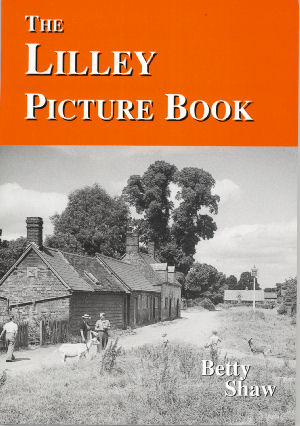|
|
The Lilley Picture Book Betty Shaw Book Castle, 2002 |

The pictures are arranged under the following headings Sketch Map Aerial View & Key to Map The Church The Rectory The School Buildings Farming Lilley Manor & the Sowerby Family People & Organisations The Fete Around & About Tithe Map 1845
``````````
|
||||||||||||
|
INTRODUCTION
Standing north of the A505 road between Luton and Hitchin, and just inside the Hertfordshire County border, Lilley has avoided the sprawling development of large housing estates found on the outskirts of so many villages to-day. In searching the many old records for information about how the village developed it was interesting (and confusing) to find that some parts of the village, (the cottages in East Street, for example) were at one time in Offley parish. Even so, many buildings date well into the past. In 1900 most of the men in the village were employed on local farms or in sup plying the needs of the community as bakers, shop-keepers, cobblers, blacksmiths, inn keepers and in providing transport. The women supplemented family incomes with domestic work in the larger houses, such as the Rectory and Putteridge Bury, or as out workers for the Luton hat industry. By the end of the century, the remaining farms employed practically no permanent staff and most people now make their living by commuting elsewhere. The school was closed in 1984, and today's children start their education in Offley, Hexton or Stopsley, going on to Senior Schools in the towns. The Post Office and all the shops have gone, and though The Red Lion closed, The Lilley Arms and The Silver Lion still draw visitors to the village. Organisations have held a prominent place in village life throughout the century. Prominent among these was the Model Club, started by Ted Holmes to provide an outlet for youthful energies in the 1930s. It began by making model aeroplanes in balsa wood, then progressed to model cars which were raced on a special track constructed in the Recreation Ground. Later Ted encouraged them to think of others and they organised a Christmas lunch for the elderly and thus the Over-60s Club was formed. The motor car, which enables most people to travel beyond the village, is a very mixed blessing at the end of the 20th century. Lilley has become the by-pass for Luton, as people hurry to and from work - a far cry from the days when the arrival of the 'Lilley Bus' was an event for the children to watch. Motorised vehicles, on the other hand, have brought many benefits to the village, apart from assisting in living here. For instance, fresh fish comes from Yarmouth every week, there is a regular delivery of milk, the mobile library comes every fortnight from Hitchin and a bus still runs from the south end of the village. The 190 I census lists 100 householders compared with 141 in the latest Electoral Roll, only 12 obvious descendants of the former list, but many more whose surnames have disappeared on marriage. Newcomers to the village throughout the century have brought fresh talents and increased the impact of such events as the Fete, the Flower Festival and the monthly Village Voice exchanging news with neighbouring villages. As the century and the Millennium closed the village suffered some sad losses, and the countryside as a whole faced an extremely difficult future but one feels that the indomitable spirit that coped with the aftermath of the two World Wars will survive. |
||||||||||||||

